
EXPERIMENTAL AND APPLIED ACAROLOGY
Scope & Guideline
Innovating Acarology: Where Research Meets Real-World Impact
Introduction
Aims and Scopes
- Ecology and Behavior of Acari:
Research exploring the ecological interactions of mites and ticks within their environments, including their roles as predators, prey, and pathogens. This encompasses behavioral studies that investigate responses to environmental factors and interspecies interactions. - Molecular and Genetic Studies:
Utilization of molecular techniques to study the genetic diversity, phylogenetics, and population dynamics of various mite and tick species. This includes the examination of symbiotic relationships and the identification of pathogens carried by these organisms. - Pest Management and Biological Control:
Applied research focused on controlling pest species, particularly in agricultural settings. This includes studies on the efficacy of biological control agents, chemical acaricides, and integrated pest management strategies involving mites and ticks. - Pathogen Interactions and Tick-Borne Diseases:
Investigation of the relationships between ticks and the pathogens they transmit, including studies on vector competence, disease dynamics, and the impact of environmental factors on tick-borne disease epidemiology. - Acaricide Resistance:
Research addressing the emergence of resistance in mite and tick populations against various acaricides. This includes studies on the mechanisms of resistance and the development of sustainable management strategies. - Host-Mite Interactions:
Exploration of the interactions between mites and their hosts, including the impacts of infestations on host health and productivity, as well as the behavioral adaptations of mites to exploit their hosts.
Trending and Emerging
- Molecular Techniques and Genomics:
An increasing trend in the use of molecular techniques, such as DNA barcoding and transcriptomics, to investigate the genetics and evolutionary biology of mites and ticks. This trend highlights the importance of genetic analysis in understanding biodiversity and resistance mechanisms. - Environmental Change and Its Impact on Acari:
Research exploring how climate change and other environmental factors affect mite and tick populations, their life cycles, and their interactions with hosts and pathogens. This area is gaining traction as the implications of climate change become more pronounced. - Integrated Pest Management (IPM) Strategies:
A growing emphasis on developing sustainable IPM strategies that incorporate biological control, cultural practices, and ecological considerations. This reflects a shift towards more holistic approaches to pest management in agricultural systems. - Pathogen Discovery and Tick-Borne Diseases:
There is a rising focus on the discovery of new pathogens associated with ticks and the implications for public health and veterinary medicine. This includes studies on emerging zoonotic diseases and the dynamics of pathogen transmission. - Use of Technology in Acarology Research:
The application of advanced technologies such as machine learning and imaging techniques in acarology research is on the rise. These technologies facilitate more detailed analyses of mite and tick behavior, population dynamics, and pest management efficacy.
Declining or Waning
- Traditional Taxonomy and Morphology:
Research focused primarily on the morphological classification of mites and ticks has seen a decline. As molecular techniques become more accessible and prevalent, studies that rely solely on traditional taxonomic methods are being overshadowed. - Generalized Acaricide Studies:
While the studies on acaricides remain relevant, there has been a noticeable decline in research solely focused on the efficacy of chemical treatments without considering integrated approaches or the ecological impacts of these chemicals. - Host Specificity Studies:
Research dedicated to understanding the host specificity of certain mite species has decreased, possibly as researchers focus more on ecological interactions and broader pest management strategies. - Laboratory-Based Behavioral Studies:
Research that examines mite behavior in controlled laboratory settings, without ecological context, has waned in favor of studies that explore behavior in natural environments or under field conditions.
Similar Journals
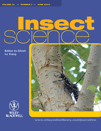
Insect Science
Unveiling the secrets of insect biology and behavior.Insect Science, published by WILEY, stands as a prestigious journal in the realms of Agronomy, Biochemistry, Genetics, and Insect Ecology. The journal, with ISSN 1672-9609 and E-ISSN 1744-7917, has firmly established itself as a significant resource for researchers and professionals seeking to explore the intricate dynamics of insects and their crucial roles in ecosystems. With a remarkable impact factor placing it in the Q1 quartile across multiple categories, including Ecology and Evolution and Agronomy and Crop Science, Insect Science ranks impressively at #8 out of 181 in the realm of Insect Science on Scopus, showcasing its influence and relevance in the field. Spanning its coverage from 1994 to 2024, this journal invites contributions that advance our understanding of insect biology, behavior, and their interactions within agricultural contexts. The commitment to high-quality research and its role in fostering interdisciplinary dialogue make Insect Science an essential platform for scholars and practitioners at the forefront of insect-related studies.
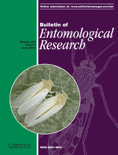
BULLETIN OF ENTOMOLOGICAL RESEARCH
Empowering Researchers with Cutting-edge Entomological InsightsBULLETIN OF ENTOMOLOGICAL RESEARCH, published by Cambridge University Press, is a prestigious journal that has been at the forefront of entomological research since its inception in 1910. With an impressive track record extending through to 2024, this journal serves as a vital platform for advancing knowledge in various related fields, notably Agronomy and Crop Science and Insect Science, where it ranks in the top quartile (Q2) and maintains a commendable position within the Scopus rankings in its categories. Notably, its contributions also intersect with Medicine in a broader scope, fostering interdisciplinary insights. While access to the journal content is not classified as 'Open Access,' its rigorous peer-reviewed articles are crucial for researchers, professionals, and students seeking to enhance their understanding of entomology and its applications in agronomy and beyond. The journal's impact is reflected in its notable percentile rankings, emphasizing its relevance and influence in the academic community. Located at the heart of the UK, the BULLETIN OF ENTOMOLOGICAL RESEARCH continues to be an essential resource for those dedicated to the study and understanding of insects and their impacts on agriculture and health.
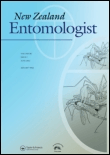
NEW ZEALAND ENTOMOLOGIST
Illuminating Insect Behavior Through Rigorous ResearchNEW ZEALAND ENTOMOLOGIST, published by Taylor & Francis Ltd, is a distinguished journal in the field of Insect Science, featuring a rich history dating back to its initial publication in 1952. As a platform for sharing innovative research and critical insights, this journal serves as a vital resource for entomologists and scientists interested in the diverse aspects of insect biology, ecology, and behavior. Although it currently holds a Q4 category in its discipline with Scopus ranking it at the 163rd out of 181 journals, the NEW ZEALAND ENTOMOLOGIST continues to uphold high-quality standards of peer-reviewed articles that contribute significantly to the understanding of insects, particularly within the unique ecosystems of New Zealand. Researchers and professionals are encouraged to submit their findings to enhance the journal's growing repository of knowledge, while students will find a wealth of information to aid their studies and foster their interest in entomological research.

Persian Journal of Acarology
Unlocking the secrets of the microscopic world.The Persian Journal of Acarology, published by the Acariology Society of Iran, stands as a pivotal resource in the fields of Animal Science, Zoology, and Insect Science. Established in 2012 as an open-access platform, this journal provides researchers and academics with a rich repository of peer-reviewed articles focused on the study of acarology, encompassing both basic and applied research. With its current ranking in the Q3 category and significant Scopus rankings in related fields, the journal fosters scholarly communication among professionals, facilitating the advancement of acarology globally. The journal’s commitment to open access ensures that valuable research is available to a wide audience, supporting both emerging and established scientists in their pursuit of knowledge. With contributions from distinguished authors and a steady trajectory of growth, the Persian Journal of Acarology is a vital tool for those invested in the future of acarological studies and applied entomology.

PHYTOPATHOLOGY
Unveiling insights to protect our crops.PHYTOPATHOLOGY, published by the American Phytopathological Society, is a premier journal dedicated to advancing the science of plant pathology. With an ISSN of 0031-949X and E-ISSN 1943-7684, this journal has been a cornerstone of scholarly communication in the field since its inception in 1946. Ranked in the top quartile (Q1) in both Agronomy and Crop Science and Plant Science for 2023, PHYTOPATHOLOGY has garnered notable recognition with Scopus ranks placing it at #86/516 (83rd percentile) in Plant Science and #69/406 (83rd percentile) in Agronomy and Crop Science. The journal publishes high-quality research articles, reviews, and case studies that explore innovative solutions to plant diseases, thereby supporting agricultural productivity and sustainability. While currently not an open-access journal, it offers vital insights and findings that are invaluable to researchers, professionals, and students aiming to advance their knowledge and contribute to the field of plant sciences.
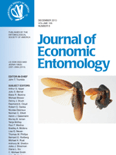
JOURNAL OF ECONOMIC ENTOMOLOGY
Connecting Entomology with Real-World ApplicationsJOURNAL OF ECONOMIC ENTOMOLOGY, published by OXFORD UNIV PRESS INC, stands as a premier interdisciplinary platform for researchers and professionals in the realms of entomology and ecological sciences. With a robust publication history dating back to 1945, this esteemed journal has consistently maintained its reputation for disseminating high-quality research, as evidenced by its prestigious Q1 rankings in both Ecology and Insect Science for 2023. The journal’s impact is highlighted by its excellent Scopus ranks, placing it in the top percentile of Agricultural and Biological Sciences and Environmental Science categories. Aimed at advancing the understanding of insects and their relationships with humans and ecosystems, the JOURNAL OF ECONOMIC ENTOMOLOGY offers a critical forum for original research articles, reviews, and opinion pieces that influence practices in pest management, conservation, and agricultural productivity. Although not an Open Access journal, its findings are pivotal for students, researchers, and professionals striving to address contemporary challenges in entomology and beyond.

PEST MANAGEMENT SCIENCE
Championing Open Access for Global Agricultural InsightsPEST MANAGEMENT SCIENCE, published by John Wiley & Sons Ltd, stands as a leading journal in the realms of agronomy, crop science, and insect science. With an impressive Q1 ranking in these disciplines, as well as in miscellaneous medicine, this journal boasts a commendable influence within the academic community, reflected by its position within the top percentiles of Scopus rankings—ranked #7 out of 181 in Insect Science and #43 out of 406 in Agronomy and Crop Science. Covering a broad spectrum of pest management strategies and methodologies, it serves as an essential resource for researchers and professionals aiming to advance their knowledge and practices in sustainable agriculture and pest control. The journal’s commitment to open access ensures that cutting-edge research is widely disseminated, contributing significantly to global agricultural productivity and ecological sustainability. With coverage extending from 2000 to 2024, PEST MANAGEMENT SCIENCE remains pivotal in shaping the future of pest management.
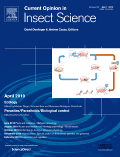
Current Opinion in Insect Science
Advancing the Frontiers of Insect KnowledgeCurrent Opinion in Insect Science is a leading academic journal published by ELSEVIER, dedicated to advancing understanding in the field of insect science. With an impressive impact factor reflected in its top quartile rankings (Q1) within both Ecology, Evolution, Behavior and Systematics and Insect Science, the journal holds a prominent position, ranking 3rd out of 181 journals in Insect Science and 35th out of 721 in Ecology-related fields according to Scopus for 2023. Since its inception in 2014, the journal has provided a dynamic platform for researchers, professionals, and students to explore and share cutting-edge developments and insights, targeting crucial topics in insect biology, ecology, and systematics. Although there are no open access options available, Current Opinion in Insect Science remains an essential resource for those looking to stay at the forefront of their research or academic interests.

BULLETIN OF INSECTOLOGY
Illuminating the Path of Insect ScienceBULLETIN OF INSECTOLOGY is a prominent academic journal published by ALMA MATER STUDIORUM, UNIV BOLOGNA, Italy, specializing in the field of Insect Science. The journal, with ISSN 1721-8861 and E-ISSN 2283-0332, has established itself as a vital resource for researchers and professionals interested in the diverse aspects of entomology and its applications. It ranks in the Q2 category for Insect Science as of 2023, placing it among the top journals in its field with a Scopus rank of 79 out of 181. The BULLETIN OF INSECTOLOGY is committed to disseminating high-quality research and innovative studies, facilitating open dialogue and collaboration among scientists. As an essential platform for sharing groundbreaking findings, it contributes significantly to the body of knowledge in agricultural and biological sciences, making it an invaluable asset for scholars and practitioners alike. With coverage from 2002 to 2024, this journal continues to foster advancements in entomological research and its importance in tackling environmental challenges.

APPLIED ENTOMOLOGY AND ZOOLOGY
Advancing knowledge in insect science for a sustainable future.Applied Entomology and Zoology, published by Springer Japan KK, is a pivotal journal in the field of insect science, with an impressive track record since its inception in 1966. This esteemed publication, bearing ISSN 0003-6862 and E-ISSN 1347-605X, contributes significantly to the understanding of applied entomology, emphasizing research that supports sustainable agricultural practices and the ecological conservation of insects. Ranked in the Q2 category (2023) for Insect Science with a Scopus rank of #65 out of 181, it is recognized for its rigorous peer-review process and high-quality contributions that push the boundaries of our knowledge. Although it does not currently offer open access, the journal remains an essential resource for researchers, professionals, and students eager to advance their understanding of the complex interactions between insects and their environment. With a focus on practical applications, it aims to bridge the gap between entomological research and real-world implications, fostering innovation and promoting informed decision-making within the scientific community.